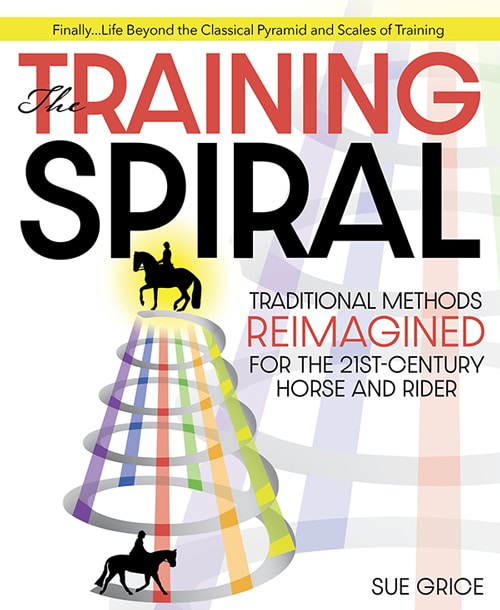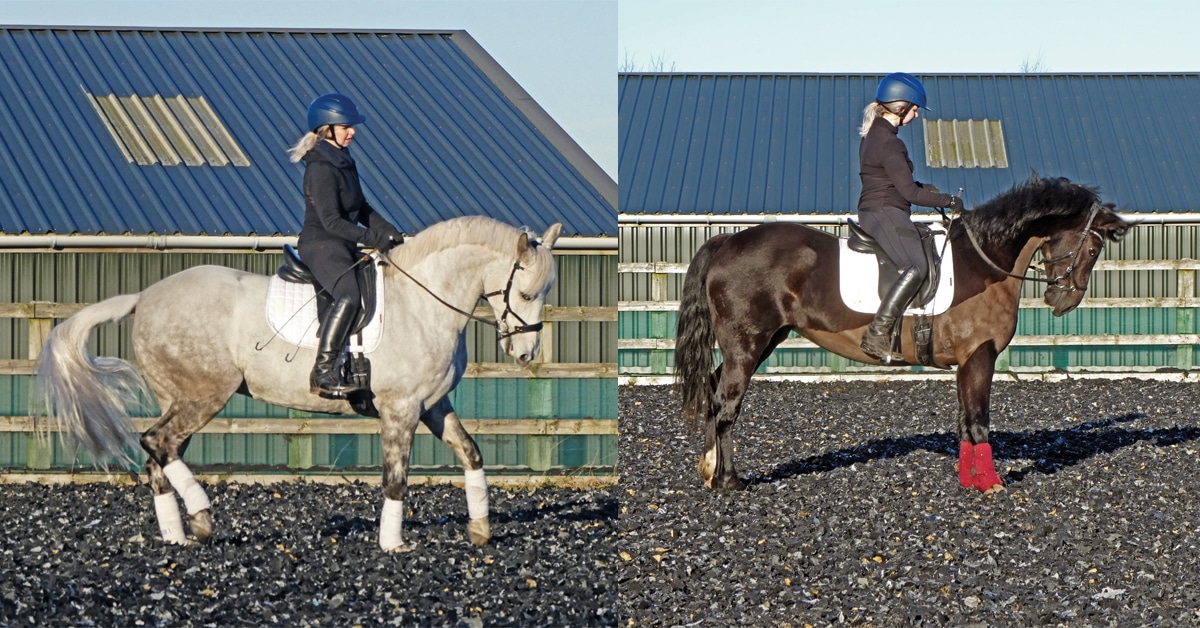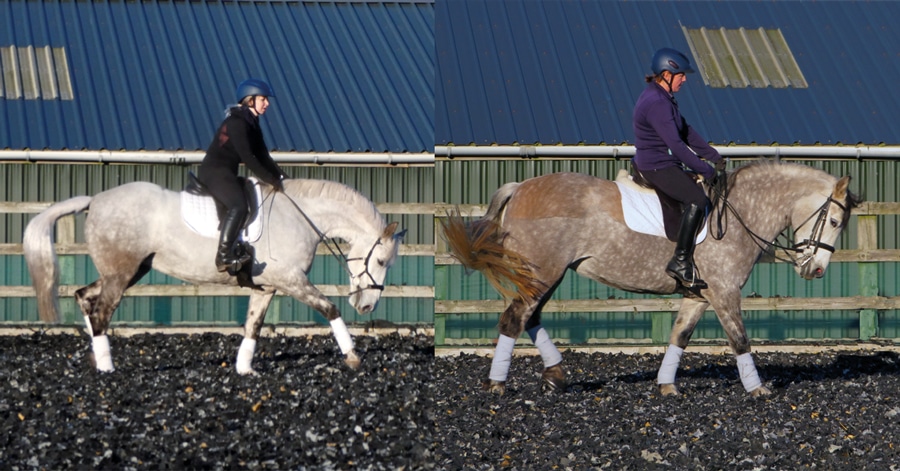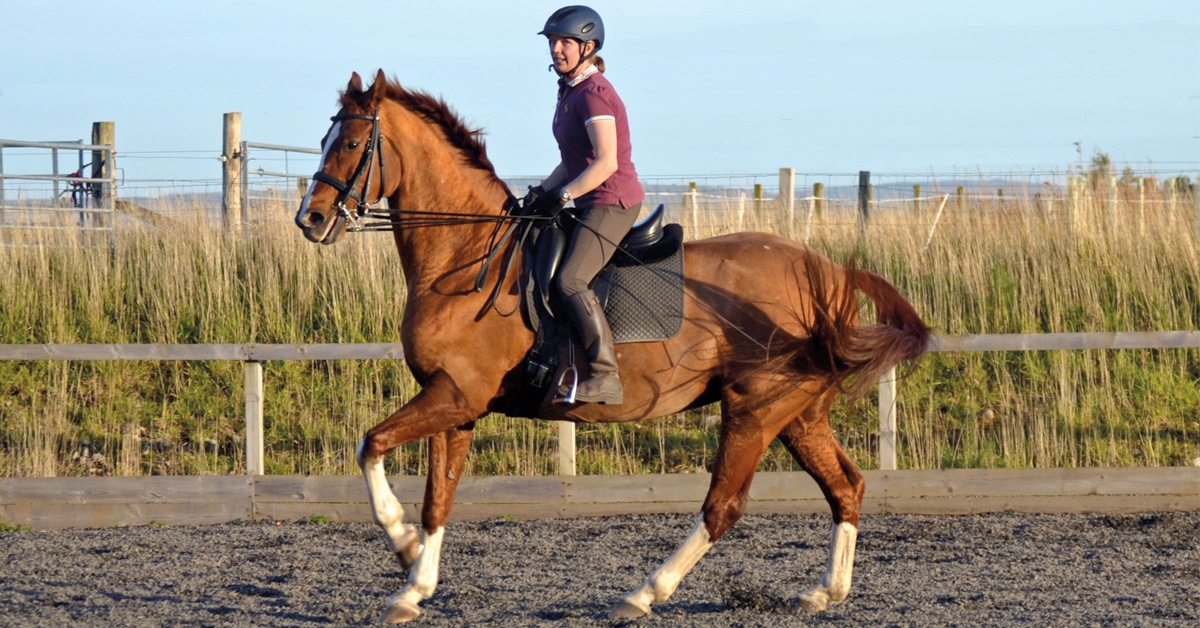There are many individual exercises that we can perform in training, and these can be used in several different ways, depending on the type of horse and the stage of training. Suffice it to say that the combinations of exercises are limitless. The aim of this book is not to provide lots of examples of such exercises, but rather to provide a concept that explains how any one exercise may be used in different ways for the different elements and levels of training.

Analyzing the Elements in Transitions
To start, let’s look at a simple trot-to-walk transition. This is something that almost all riders and horses can manage—the only exceptions being the most novice of riders and perhaps horses at the very start of their training career.
How can we judge the quality of a trot-to-walk transition using the elements of the Scales of Training? What are the questions to ask and the most common problems to arise?
Rhythm
Does the horse maintain a good clear Rhythm before and after the transition?
A good Rhythm makes the transition look and feel smooth and fluid, with the horse traveling forward in a relaxed way. The rhythm change (in this case, from the two beats of trot to the four beats of walk) should appear seamless.
Common Problems
The horse often goes from a trot to a walk, but then jogs a step or two before finally finding a clear walk beat (below left). This can indicate a lack of relaxation. On the other hand, sometimes the horse will go from trot to halt before moving off into walk (below right). This lack of relaxation and forwardness will result in a lack of Rhythm directly before or after the transition.

During this trot-to-walk transition, the horse in Photo A (left) has tensed up and lost his relaxation, causing him to shorten his stride and jog from the trot to the walk. The young horse in Photo B (right) has dropped from trot directly to halt when being asked to walk, which also causes a loss of the desired rhythm in the walk.
Suppleness
Does the Suppleness in the horse remain the same through the transition?
Ideally, the horse will be able to maintain the Suppleness in his muscles through the transition from one pace to the next.
Common Problems
The horse may tighten in his body as he performs the transition, which will present in his neck becoming stiff and raised up (see opening image). Any kind of bracing from the horse is likely to cause the transition to become jerky or abrupt, although the Rhythm before and after may remain true.
Contact
Does the horse maintain a nice feel on the rein, taking the rider’s hand gently forward? Does he respond to signals through the rein and body that prepare him for the transition? Does he stay forward, soft, and accepting throughout the transition?
Ideally, the horse should not get heavier or tighter, or block against the rein contact, when performing a transition. This applies likewise to the seat and leg aids that the rider applies.
Common Problems
The horse may take hold of the rein contact or block against it and push forward (or dive) through it (below left). Alternatively, he may drop the rein contact by becoming too light on the rein and not taking the rider’s hand forward enough (below right). There are several reasons why a horse may do these things, but one surprisingly common cause is that he does not fully understand the question that the reins are asking; as a result, he tries either to avoid the contact or to take charge of it.

The horse in Photo A (left) is clearly taking hold of the reins and diving through the contact to the extent that the reins have even pulled the rider forward out of the saddle. In contrast, the horse in Photo B (right) has dropped the rein contact and is not taking the rider’s hand forward at all.
Impulsion
Does the horse maintain a good level of Impulsion (energy) before, during, and after the transition?
Ideally, the level of energy should not increase or decrease through a transition. Remember, walk is not necessarily a lower-energy gait than trot. It is just a different beat—that is, the legs are working in a different sequence and Rhythm.
Common Problems
One of the most common problems when going from trot to walk is that the level of energy or Impulsion can decrease. As a result, the horse, who may have had a good quality, active trot, moves into a walk that is lacking energy. Although the Rhythm may be a clear four beats, and the Suppleness and Contact remain good, the walk itself may be considered lazy, and the rider has to work hard to maintain the walk rather than the horse showing a desire to move forward.

While riding a trot-to-walk transition, this horse loses his straightness and falls through his right shoulder.
Straightness
When riding a transition on a straight line, such as the centerline, does the horse stay straight and travel on two tracks?
Ideally, the horse will maintain the alignment (Straightness) through his body when performing a transition.
Common Problems
It is not uncommon for a horse to lose Straightness when performing a transition, perhaps most typically by falling out through his outside shoulder (left). However, some horses have a tendency to move always through the right or the left shoulder, whether this is the inside or outside one.
Collection
Does the horse feel as though he maintains a lightness and balance in his body as he performs the transition?
Ideally, the horse will maintain, or even increase, the degree of “sitting” power (Collection) he already has from the trot through to the walk.
Common Problems
In a downward transition (for example, from trot to walk) a horse can often lose the Collection, which can be identified by the horse “diving onto the forehand.” In other words, his body weight shifts from his hindquarters onto his shoulders, and he becomes downhill in his way of moving.

Here you can see the horse has lost his collection and is falling downhill onto his shoulders during a canter-to-walk transition.
As the horse works with the more advanced levels of Collection, it is easy for him to get “stuck” in the collected pace and lose the forward desire. This can occur when the horse begins to carry too much weight with his hindquarters and doesn’t have enough forward impulsion—he “bounces” up and down with little or no forward inclination. Once again, when you find problems occurring at the highest level of training, the issue is most easily fixed by returning to a lower tier of the Spiral and progressing upward once more.
When riding a transition, the six elements (Rhythm, Suppleness, Contact, Impulsion, Straightness, and Collection) can be identified by any level of rider at any level of training (it is part of a rider’s training to become increasingly aware of them). The difference between novice and advanced levels lies in the degree of quality and precision that is being asked for and is expected from the horse. For example, a rider at Introductory Level may need to use an increased amount of rein contact to ask the horse to perform a transition from trot to walk, whereas a Grand Prix rider may rely almost entirely on subtle seat aids. Similarly, at Introductory Level it is satisfactory for a horse to move from trot into a walk that has a clear four beats but is lacking a little in energy. As long as the horse is still moving forward in walk, it may be acceptable. However, at the more advanced levels a rider would not be satisfied with a “lazy” walk and would require a much higher degree of Impulsion from the horse since he may be required to perform an advanced movement from the walk.
There is no precise rule as to what is acceptable or not acceptable at each level, as training should always be tailored to the individual rider and horse. The Training Spiral is not a series of rules but rather a progressive pathway that a rider or coach can take when training a horse. Knowing exactly where one is on that path, and how big a step to take next, is part of the art of training.
***
Order your copy of The Training Spiral from Trafalgar Square Books here.
https://www.horseandriderbooks.com/store/the-training-spiral.html

